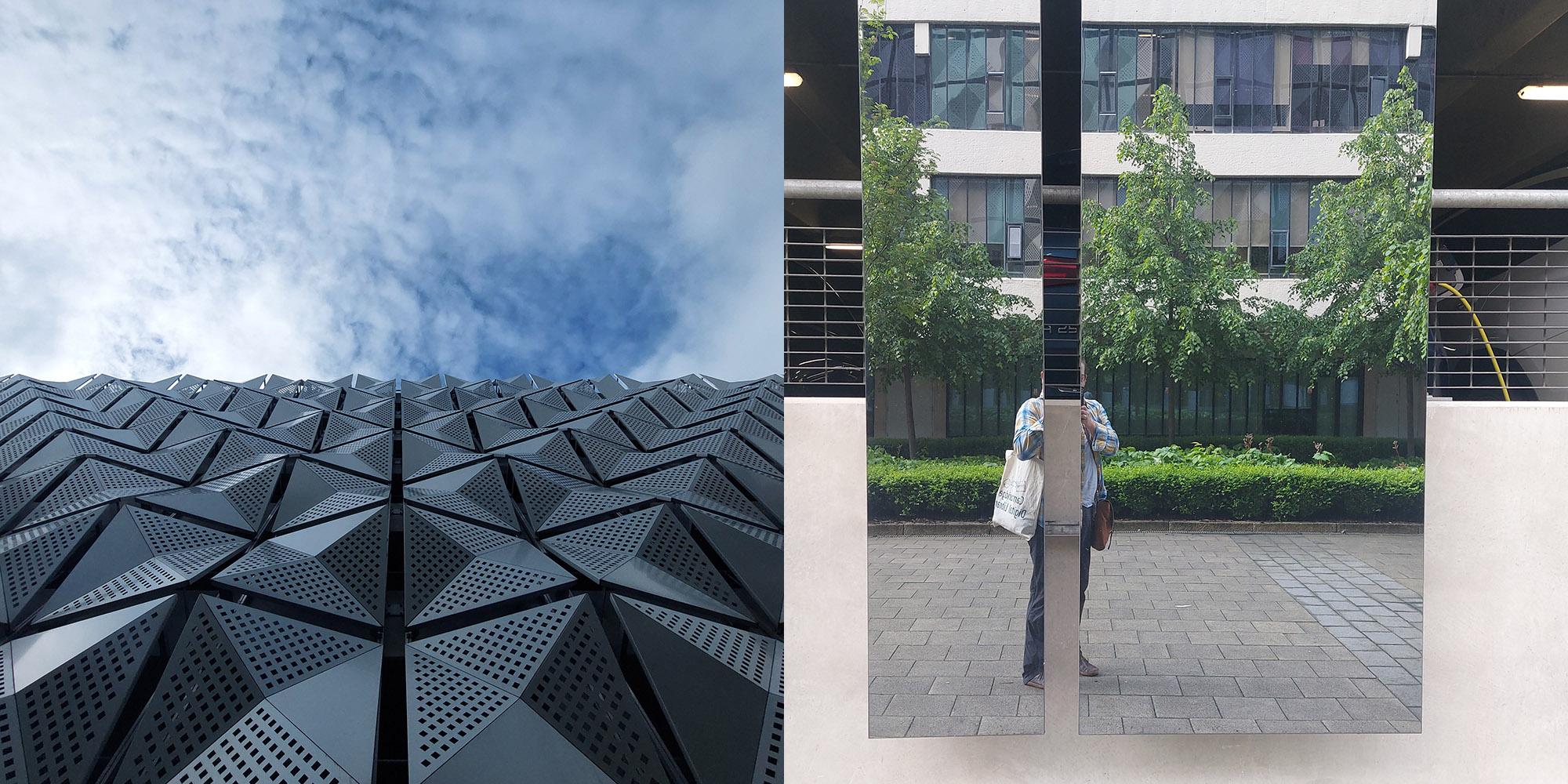Vignette: Leeds University Library
by Andy Corrigan
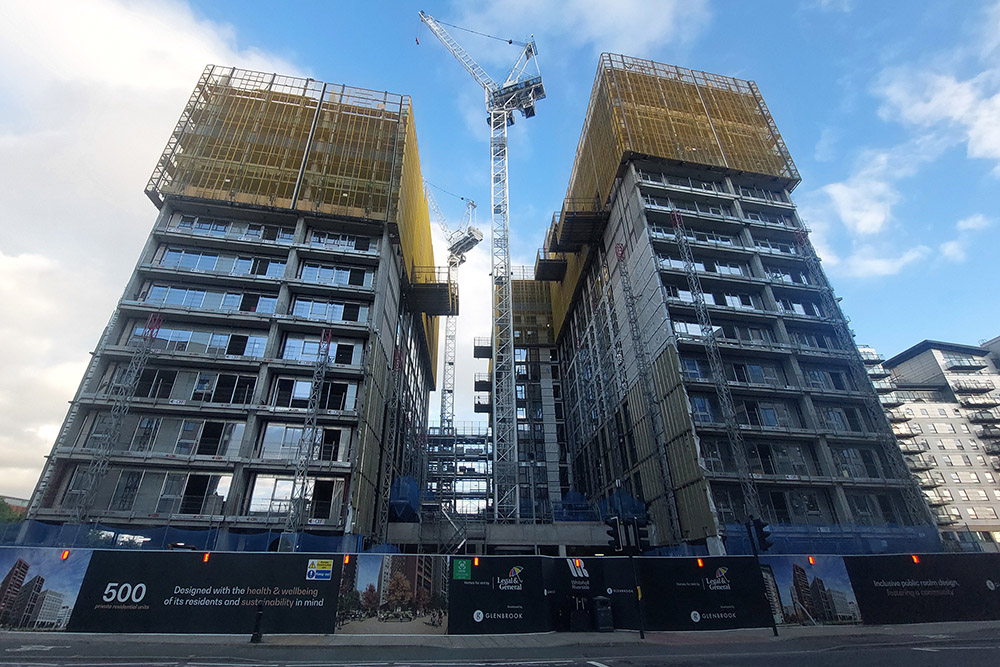
– Two identical apartment blocks under construction, with two tall cranes in between them, near Wellington Place, Leeds.
First Impressions
Arriving in Leeds the day before my visit to the library, I wandered down to the river for a look around. The skyline of Leeds is busy with shiny office and apartment blocks, and perhaps busier still with scaffolding, advertising mantels and cranes – those ephemeral precursors. The Wellington Street area seems almost entirely new apart from the short stumpy tower of an old train wagon lifting hoist, recently re-opened as a museum, that now stands at odds to its surroundings. The river, a murky rich brown, is an oozing corridor of nature that clings to its more verdant edges – the hue adding a warmth to the reflecting sky. Something else that stands out is the unusually large number of Monkey Puzzle trees, penned into their allotted green spaces.

– The Wagon Lifting Hoist Mini Museum, Wellington Place in Leeds, also showing it’s reflection in a nearby glass office block.
The next morning, as I embark on my hunt for the library, the shiny university car park is another reminder of modernity, but I soon find an architectural counterpoint as I make my way past the Clothworkers Centenary Concert Hall and rows of contemporary Victorian red brick houses. To my surprise, a colony of rabbits is grazing the lawns as bold as brass and seemingly indifferent to the passing people. I was later told that they had moved in and developed this apathy during the COVID lockdown period.

– Rabbits grazing the lawns on campus in Cavendish Rd.
The Parkinson Building at the University of Leeds shares aspects of form with Cambridge University Library (CUL) – a grand stepped entrance and a tower flanked by two boxy wings. But I’m greeted by something altogether less angular and more radial as I find my way into the Brotherton Library to meet Claire Knowles, their Associate Director of Research and Digital Futures. It turns out that both buildings are roughly contemporary with the 1930’s CUL. The view from Claire’s office looks out into the space between the circular Brotherton and the straight buildings that fortify it, giving the sense of a treasure filled castle keep. Although a drabber red brick than the Brotherton’s lavish marble interior, or the Portland Stone façade of the Parkinson, the juxtaposition of the straight and curved walls draws the eye and mind.
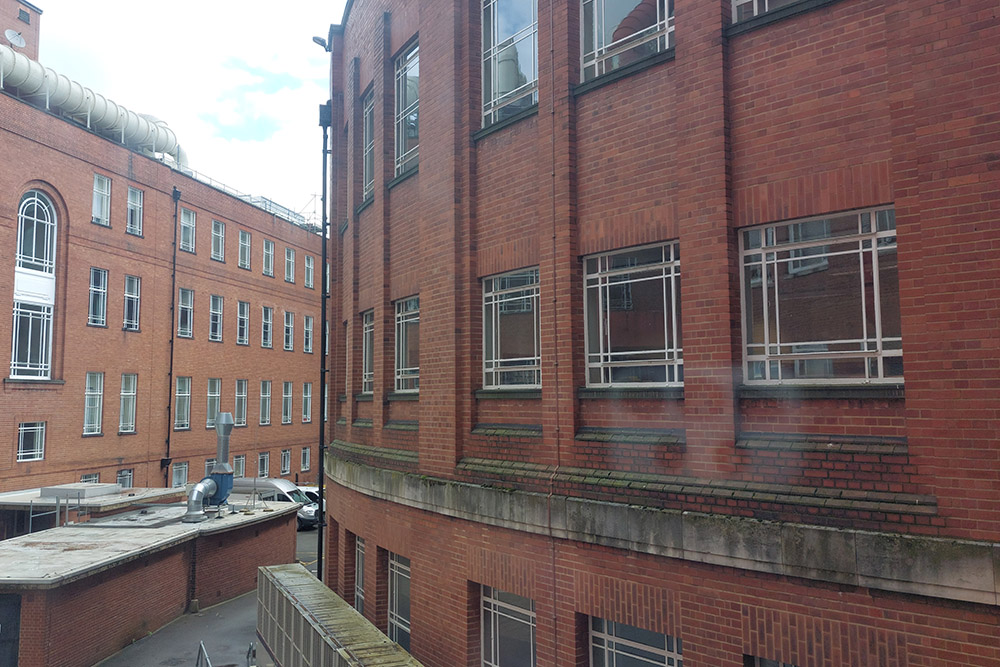
– The view from Claire’s office, with the circular exterior of the Brotherton Library on the right.
The imaging studio - bread and butter
I first met Claire through working on IIIF initiatives – and after a catch-up and general overview of the digital landscape at Leeds, she took me through to visit the digitisation studio team. I was introduced to Rob Fitzgerald (Digital Access Co-ordinator) who kindly showed me around and discussed the teams work with me. Whilst more modest in scale than the studio at Cambridge, there are of course many parallels here, the first is their three streams of input:
- Mass digitisation projects
- Orders from researchers and members of the public
- Internal orders – specific requests for exhibitions, comms or smaller projects
Their internal image ordering workflow is something they’ve been ironing out with the exhibition and comms teams across the library. This ensures good lead-in times, clear communications and understanding. Aspirational capacity to digitise entire items regardless of how many pages might be ordered is perhaps another commonality but, as at CUL, there is pragmatism about what’s possible verses what’s reasonable with limited resources.
I’ve often wondered if these spaces for flexibility are an overlooked area when it comes to the impact decision makers can have on the depth of “personality” of their output, or what insight it might give about the teams themselves? Initiatives such as the Technicians Commitment are having an impact on acknowledgement – Rob and his team showcase their work through the Technician’s group at Leeds, and Claire feeds into the university’s Fair Attribution Guidelines for Technicians and Specialist staff.
Currently situated within the Special Collections division, the team has shifted in the library’s departmental structure several times over the years, which is also something we have in common at CUL, and anecdotally something I’ve heard from others in this area. I wonder if there are any ways to measure the impact of structural stability/instability on such teams in the industry? The wider team at Leeds doesn’t have specific “Digital Curators”, although they do have Digital Archivists and dedicated storytellers. The imaging team themselves raise their profile through occasional blogs and are keen to do more of this to highlight their contribution and voices. One challenge they face is a simple one – getting people to put links back to content in their outputs. I’ve certainly come across the same issue, and whilst it gives me solace that it’s not just me, it does raise a good question of why this is, given it’s so simple to incorporate links in digital content? – Is it simply that people don’t have time for the smaller details? I wonder if the increasing use of persistent identifiers will have a positive effect on this issue and Rob points out that they’ve been seeing more people using ORCID’s, and deeper considerations of paradata, a key element in the London Charter. Identifiers are currently a hot topic at Leeds, they have a large project underway around their infrastructure, and we were joined by Jodie Double (Digital Content and Copyright Manager) to discuss how the digital content work fits in with that.
DLIP
Their digital future is being built from the ground up, so their Digital Library Infrastructure Project (DLIP), launched in July 2023, is designed to be a strong foundation. Not only is it planning to transform digital access, but it is actively considering the opportunities that that brings for learning and research. A key aspect is that their strategy incorporates both their collections and their research infrastructure, acknowledging their close relationship.
The process has involved expanding the team and engagement and relationship building with suppliers and consultants. In addition to scrutinising and refining technical architecture and roadmaps, stakeholder engagement has gathered input from the wider university community as they are mindful of being able to deliver impactful solutions to this key user group.
Working in an agile way has been a culture shift for library staff but helps when tying into supplier workflows. Another challenge is that there are many possible solutions and combinations but no one-size-fits-all approach. So, there’s a lot to work through, and that will take time, but their emphasis is on getting it right for the long term rather than speed. It’s hoped that the result will provide quality headspace in which to collaborate on more creative and experimental activities with their learning and research communities. The digital shift has taken some getting used to, things change ever more quickly, and solutions need ever deeper exploration. I think we can all agree that with technology becoming more fluid, recognition that investing in people that can respond to that is becoming more crucial.
I’m reminded of the construction process, to which most commercial archaeology is tied to in this country, and in which I used to work. It’s a good analogy for anything that involves an empirical approach that seeks to develop a deep understanding. There are a number of steps which are broadly parallel:
- You investigate and understand the lie of the land – the geology.
- Construction is designed in response to that.
- Archaeological evidence that might be impacted is investigated.
- The process of flattening elements of data into a vector allows the relationship of each aspect to be understood in its context, building up the understanding of the whole.
- Through consultation, plans are adjusted in response to mitigate.
- The end result is a holistic understanding and a finished construction – the two aren’t independent and can’t be siloed.
Since my visit, they have built a prototype that incorporates plans for their new Collections website, as well as a PID factory.
SPARKLE
One of the interesting projects at Leeds recently is called SPARKLE (Sustaining Practice Assets for Research, Knowledge, Learning and Engagement). Claire Knowles was a Co-Investigator on the project, which aimed to build understanding and scope the needs of practice-based research outputs and infrastructures. Given the pertinence to my own work I was keen to discuss the project’s outcomes and hear about any next steps. The key findings of the Final Report present a tantalizing glimpse into issues around the use, presentation, access and reuse, that need addressing to support practice researchers in their work.
The project draws out the important roles of authenticity, sense and experience, the more human aspects that standard digital infrastructures strip out due to their over-rationalisation. Whilst reaching some great conclusions, Claire is keen to highlight that as with many great ideas, any next steps are reliant on further funding. However, it’s great to see something which begins to highlight the complexities and nuances of the practice-based research outputs that are becoming increasingly entangled with the digital landscape and to contemplate their future.
Since my visit, I was glad to subsequently see Claire and Scott McLaughlin (the PI on SPARKLE), join forces with the team from a parallel project, PRvoices, to present on a panel at the ‘Capturing Creativity Week 2024’. It was encouraging to see them continuing to advocate their shared mission and seeking to build on the success of their work in ‘PR Voices and Sparkle: Working in co-design with community’.
Lunch
Being “taken to The Librarian’s Office” is a phrase that has connotations of having done something naughty at school in your childhood. This Librarian’s Office has a friendly lunch and some more people to talk with about exciting digital things, including Masud Khokhar, University Librarian and Keeper of Brotherton Collection. An open, progressive, and friendly approach is clearly an ethos that pervades down from the very top here. An opportunity for a relaxed chat, and a reminder that formal settings can be surprisingly welcome in the right hands …
XR Spaces
Prior to my visit I’d seen that the library’s services incorporate a Makerspace and wondered how that might fit into things. Whilst the member of staff that oversees this service was unable to be present during my visit, Claire took me for a post-lunch stroll around to see some of their facilities and spaces. What I saw was really quite enviable – the Library Makerspace service is embedded in HELIX, a learning and innovation hub for the university that sits within a Digital Education Service team.
This seems incredibly well conceived and is supported by a strategy that not only seeks to enable and innovate facilities for students and staff, but HELIX is also usable by the local community. A rich variety of media suites, XR facilities, learning, collaboration and enterprise spaces, on top of the Makerspace seems truly cutting edge. One prominent, perhaps even daunting, facility is the UK’s first Omnideck, a 360-degree treadmill that enables freedom of movement during immersive experiences!
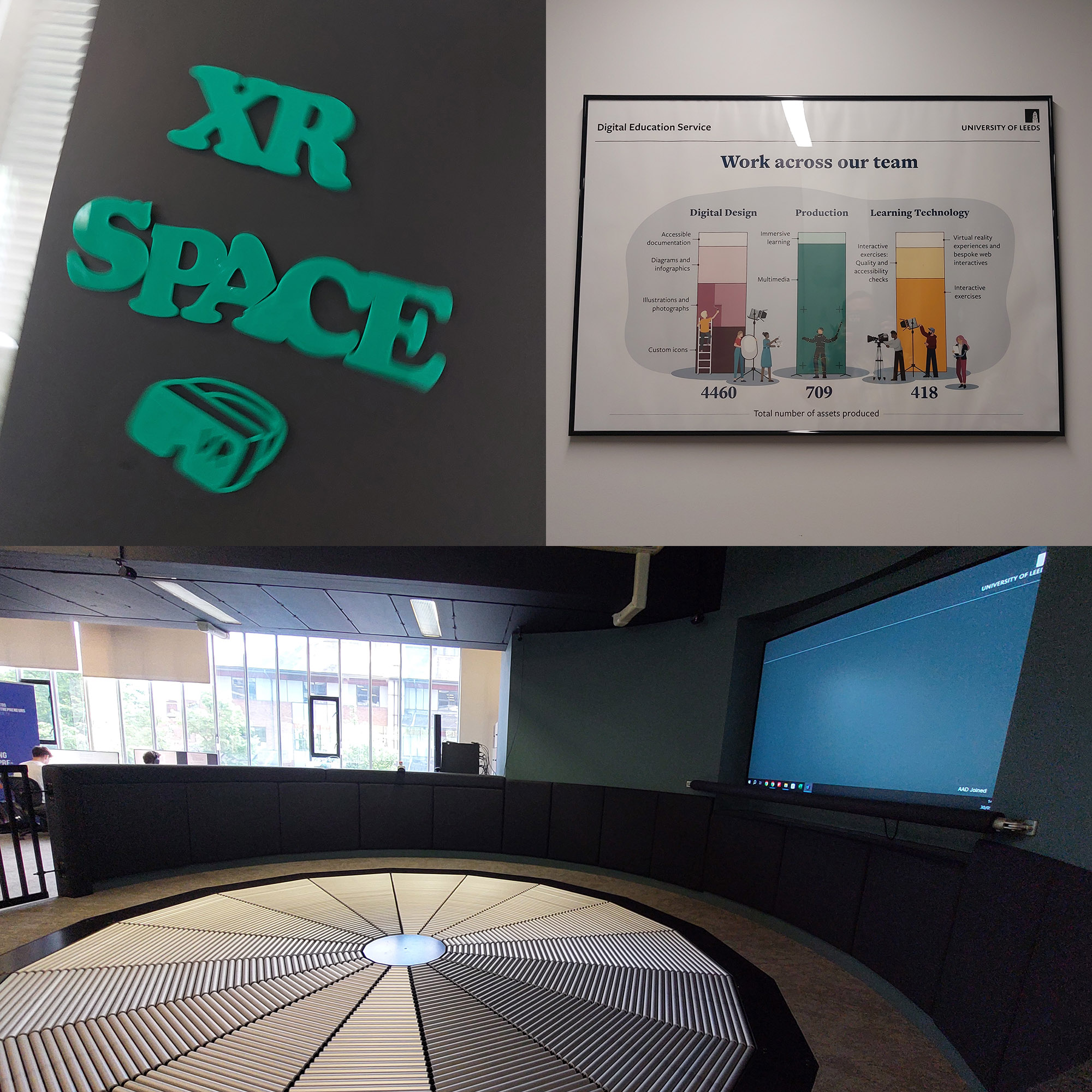
– The “XR Space” sign in HELIX, and the Omnideck 360-degree treadmill.
Whilst only having had a brief chance to see the Makerspace facility, and Claire points out that they are still finding their feet with it all and figuring out the potential, several things stand out in relation to my research. Firstly, the way these facilities are situated as a standalone hub that is open to all, the vision of which seeks to engage, enable and innovate through technology and digital pedagogy. This places digital education and technology at the core of practice and method rather than piecemeal elements that support individual or siloed activities. Another thing that stands out for me, is that this technological epicentre doesn’t define digital technology as something disparate from physical human activity, but rather embraces the embodied nature of a hybrid world. Hand tools, sewing, gluing, walking and collaboration are just as much a part of this landscape as the screens, headsets and software. The phrase “Digital Transformation” and the need to inspire and enable is clearly taken very seriously!
DCCH
The name ‘Digital Creativity and Cultures Hub’ (DCCH) is one that could probably mean anything, and could turn out to be something, nothing, or everything. In an international ocean of homogeneous “digital” centres, hubs and labs, it’s tricky to stand out, develop a personality, convince people that’s a good thing, make stuff happen, and then celebrate all that, it’s a tall order. So, I didn’t really have any particular expectations when Claire, took me to see the DCCH space and meet some of the team there. If anything, I was slightly flagging by this point in the day, there had already been such a lot to take in!
But gladly my mind wasn’t in for any let-up. Despite its youth, having been launched in late 2023, and its humble resources – which principally consist of a very compact team with an academic lead, that have a repurposed space to use just off from the Brotherton’s epicentre – the achievements of the team are truly mighty and inspiring. Their primary purpose is to support and encourage use of the collections through co-ordinating digital humanities (DH) approaches and activity. I probably could have chatted about exciting projects and people for another whole day with Cassie Ulph (Digital Development Manager), and Simon Popple (Academic Lead/Senior Lecturer in Photography and Digital Culture).
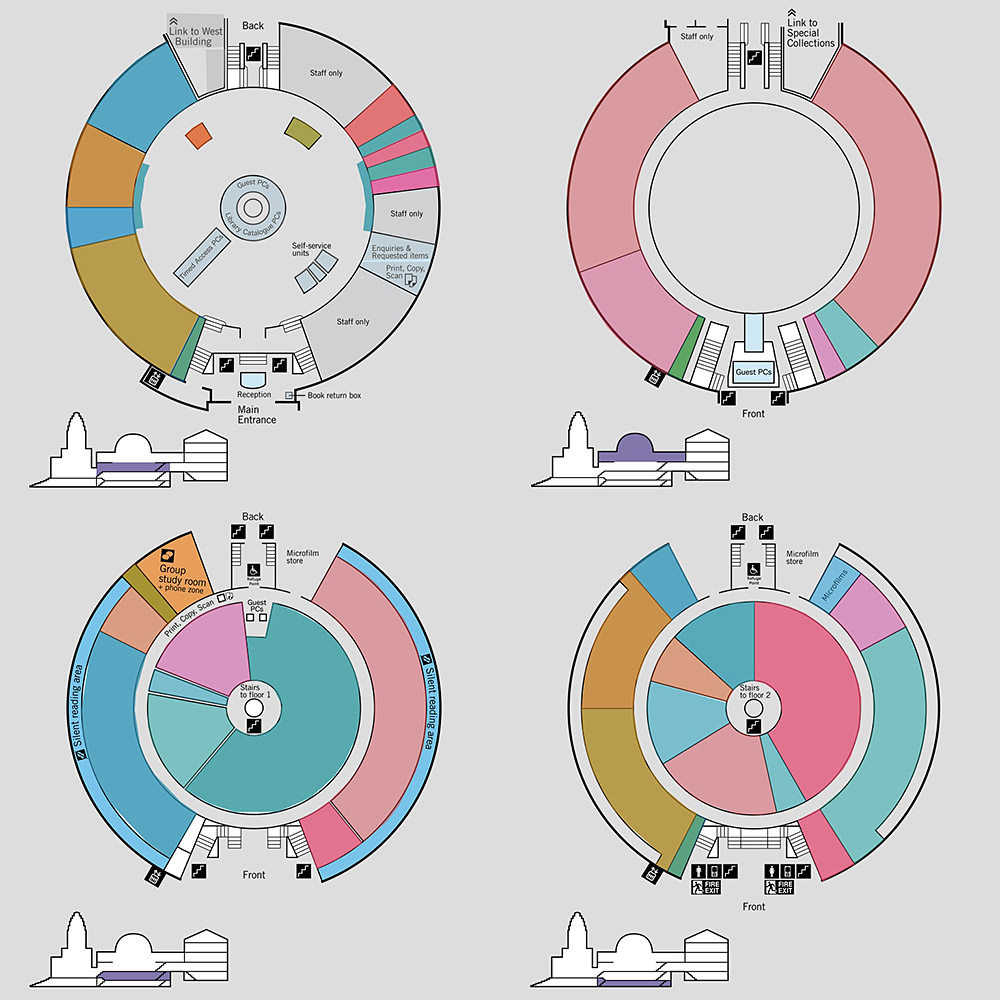
– Schematic plan showing the four floors of the Brotherton Library, which highlight the radial circular form. The DCCH occupies what was once a “staff only” space.
Whilst their core activity consists of providing a focal point for their university-wide Digital Humanities Research Group and a series of events and training that coalesce around DH activity, I was most excited to hear about their Internship Programme, which over 2023/24 supported undergraduates with paid work on projects around five themes based on the library and cultural collections. Drawing both undergraduates and staff mentors from across a variety of disciplines enabled creative and technical skills to collaborate. Some of the projects have a community focus, such as work on the ‘Welcoming Migrants Project’, which has been aiming to open University collections to migrant communities, and the ‘Born in Bradford - Digital Makers’ project, which has been developing digital skills training for school children in the Bradford area. Whilst others were more focussed on specific collections, tools and methods, by incorporating aspects of IIIF, AI and 3D.
The breadth and achievements of these projects is astonishing, not least considering that they have been undertaken by undergraduates working alongside their courses and studies. Programmes such as this are obviously not without their challenges, but the pay-offs in terms of enrichment to the matrix of collections and people is clearly hugely impactful.
Since my visit, these projects have been concluding with some inspiring outcomes and journeys:
- Lexi Zhong has been bringing historical furniture archives to life by applying creative experimentation to produce digital interpretations.
- Lili Jaber has been using AI and creative tools to digitise historical recipes in their project, ‘From Manuscripts to Modern Meals: Digitising Historical Recipes with AI’.
- Samuel Yeung has been ‘Identifying locations in the Bingley Photographic Collection with AI’.
- Maia Hutton Mackay and Harith Ibrahim have been exploring how IIIF might allow different ways to engage with a variety of dimension and sense challenges to heritage collections such as ancient coins and textile patterns.
Conclusions & after-thoughts
It had been an exciting and rewarding, yet somewhat exhausting day. As I began my long journey home I didn’t feel much like I could do any more contemplation. Trying to find my way out of an unfamiliar city during rush hour was a challenge, even with a sat nav. I inevitably ended up in the wrong lane at one point, finding myself veering off in entirely the wrong direction. The heavy traffic meant I had to just go with the flow and ease my way back on course, but in doing so, no doubt helped by the tiredness, I found the experience a bit of a revelation in summarising my visit. Unlike the flatness of Cambridge, Leeds is naturally an undulating city and the human infrastructure adds further to the sense of levels – the bridges, tunnels, over and under passes, skyscrapers and cranes, the old and the new. It has a sense of dynamic complexity and solidity. The sensation of driving around the city, even at the slow pace of the heavy traffic, felt a little like being a pinball in an arcade game. Maybe this is a driver for inspiration and curiosity? In Cambridge we must make do with glimpses through vertical windows, doors and gateways to spike our curiosity, there are very few places in the city that give a rare opportunity to change your horizontal perspective.
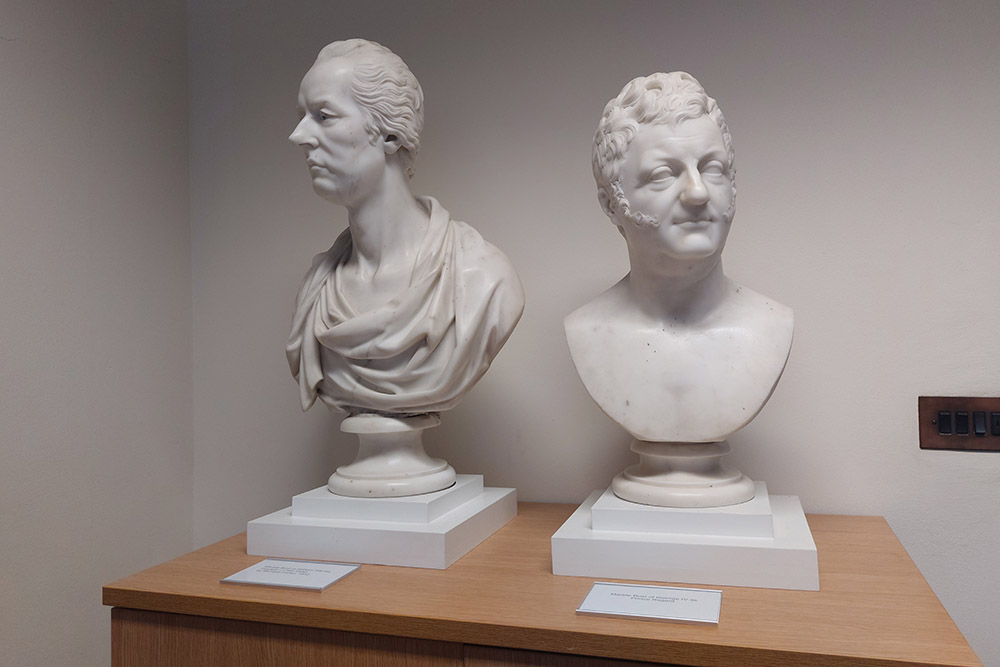
– Marble busts of William Pitt the Younger and George IV.
There was definitely a sense for me that this dynamic spirit was also present and reflected in the University Library and its approach to the digital landscape/ecosystem. Even if it might not be at its destination (if there even is one for a digital landscape), it’s going somewhere exciting, and yet in a solid way, and that was very inspiring to take a glimpse at and experience. Even if the marble busts of William Pitt the Younger and George IV look slightly cheesed-off at being left-behind and relegated to an office corner. Whilst the city might be constraining nature – the river and monkey-puzzle trees – the library is allowing creativity and the digital landscape to flourish here, which provides a strong example of that ethos of becoming less transactional that forms such a key part of the RLUKs Digital Shift Manifesto
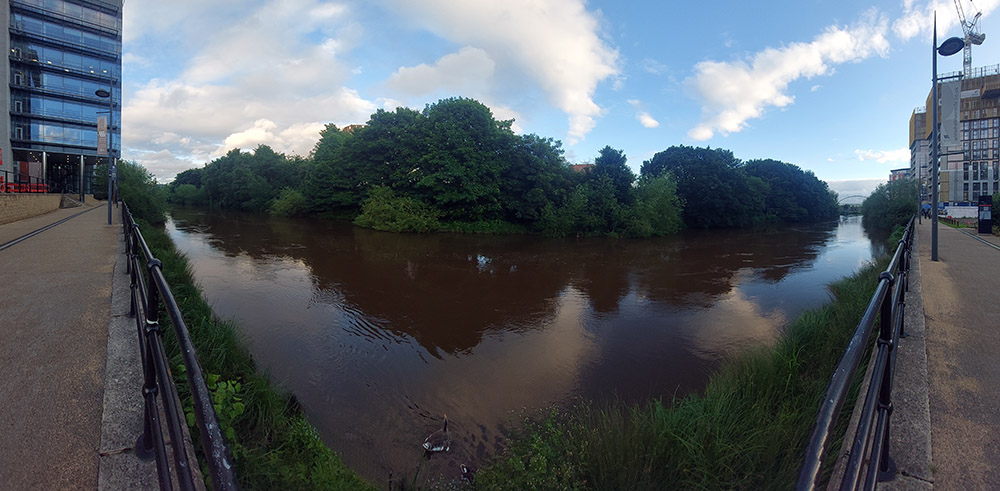
– A panoramic photo of the River Aire taken from the bank near Riverside Way.
You can explore the photos from my trip in more detail using this IIIF viewer:
This post has been funded by the AHRC-RLUK Professional Practice Fellowship Scheme for research and academic libraries.
